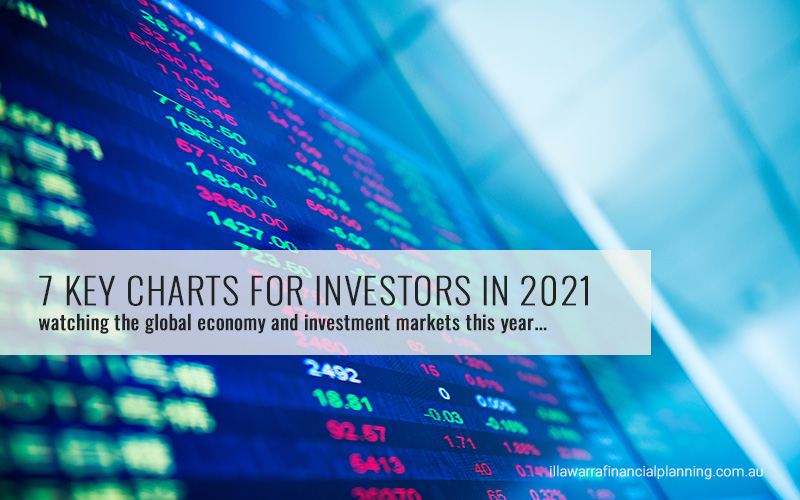Key points
- Shares are at risk of a short-term correction or consolidation, but investment markets should provide solid returns this year on the back of continuing economic recovery and low interest rates.
- Seven key global charts worth keeping an eye on by investors this year are: the trend in new coronavirus cases and deaths; global business conditions PMIs; unemployment; global inflation; bond yields; the gap between earnings yields and bond yields; and the US dollar.
Introduction
Our high-level investment view is that while shares are vulnerable to a short term correction having run up hard since early November, overall investment returns will be solid this year on the back of economic recovery (driven by stimulus and the deployment of vaccines allowing a more sustained reopening) at the same time that interest rates remain low. And we are likely to see a further shift in relative returns to investments that benefit from recovery - resources, industrials, tourism stocks and financials. This note looks at seven charts we see as critical to the outlook.
Chart #1 – new coronavirus cases
The deployment of vaccines holds hope for a sustained global reopening and return to something more normal and our base case is that this will be successful over the next year or so. Key to watch will be the trend in new coronavirus cases and deaths.
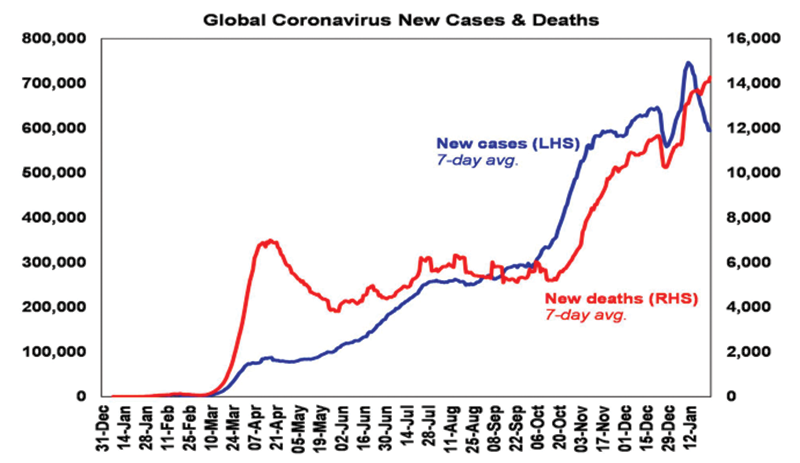
Source: ourworldindata.org, AMP Capital
Global new cases have slowed again lately but this appears to owe more to the latest round of lockdowns as only around 5% of developed countries’ populations and less in emerging countries have been vaccinated. Uncertainty remains around vaccine effectiveness in preventing infection and serious illness, their effectiveness against new mutations, how long protection lasts for, what portion of the population will need exposure or vaccination for herd immunity, etc. That said, there are some positive signs regarding vaccine efficacy beyond formal trials out of Israel where vaccination is above 30%.
Chart # 2 - global business conditions PMIs
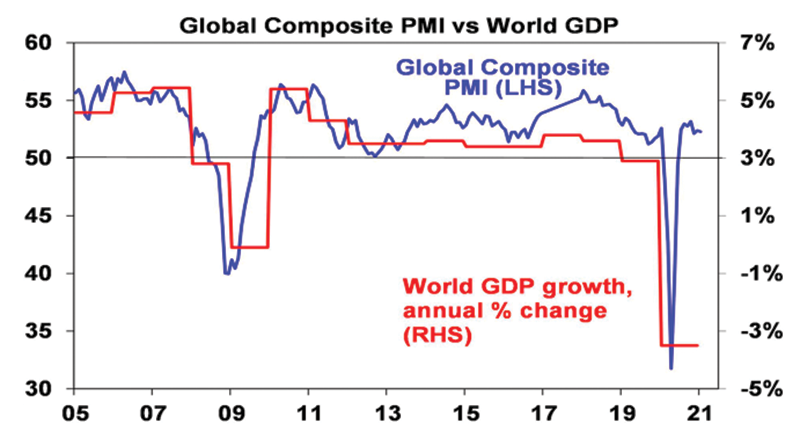
Source: Bloomberg, AMP Capital
Global Purchasing Managers Indexes (PMIs) – surveys of purchasing managers at businesses in most major countries – are an excellent and timely guide to the state of the global economy. Since the initial lockdown lows early last year they have rebounded sharply, albeit with the services sector still lagging given distancing restrictions and remain consistent with strong growth this year. They will ideally need to improve further to see our expectation for global growth of over 5% this year and to underpin a strong rebound in profits.
Chart 3 – unemployment and underemployment
At present, investors face the ideal backdrop of improving growth but low interest rates. Key to watch in terms of the latter is spare capacity. One of the best measures of this is unemployment and underemployment
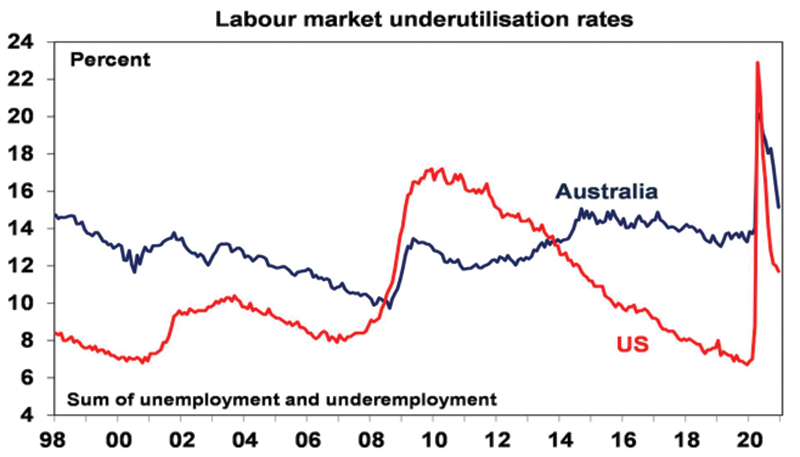
Source: Bloomberg, AMP Capital
The combination of unemployment and underemployment has fallen sharply from last year’s highs but remains relatively high in the US and Australia. A continuing sharp fall from here would bring forward the time when central banks move from easing to being primed for tightening. That said we have a long way to go to full employment as even pre-coronavirus levels did not generate much inflationary pressure.
Chart 4 – global inflation
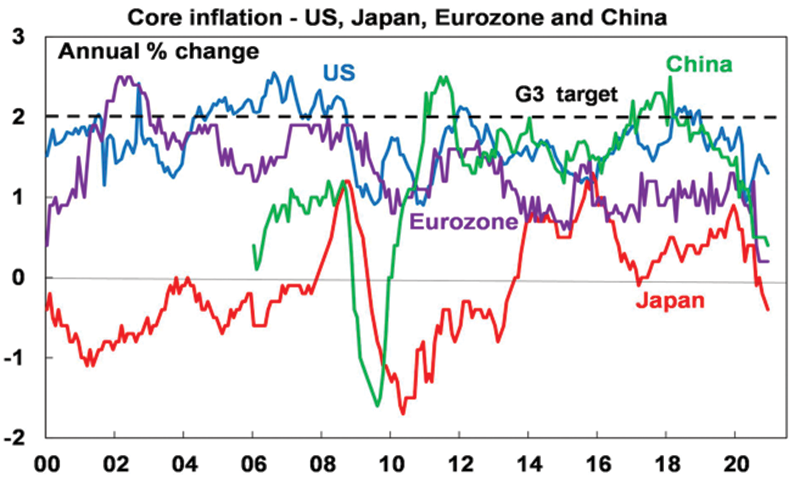
Source: Bloomberg, AMP Capital
This year has started with a bit of an inflation scare and US and Australian headline CPI inflation measures look like rising to around 3.5-4% over the year to the June quarter as last year’s June quarter price slump drops out of annual calculations and higher commodity prices feed through. Core and underlying inflation measures will remain the main focus of central banks and right now they are well below target in the US, Europe, Japan and China as is the RBA’s preferred measure of underlying inflation in Australia at 1.2% year on year.
Chart 5 – bond yields
Long term bond yields plunged in the initial stages of the pandemic on safe haven demand and then as central banks bought bonds to inject cash into their economies. Higher long bond yields and steeper yield curves (i.e. the gap between long term yields and short-term interest rates) are part and parcel of economic recovery as a result of less saving and more borrowing.
If we don’t see higher bond yields it would raise concerns that risk taking and investment – or borrowing short and lending long – may not occur. That said, we don’t want bond yields to rise too far too fast lest they boost borrowing costs too quickly and so crimp the recovery and put pressure on share market valuations – as occurred in 1994. So far so good with bond yields up from last year’s lows (by around 0.5% in the US and Australia and less elsewhere) but not dramatically so. More upside in yields is likely this year but too rapid a rise – perhaps as investors who are loaded up on bonds seek to offload them - would be a concern.
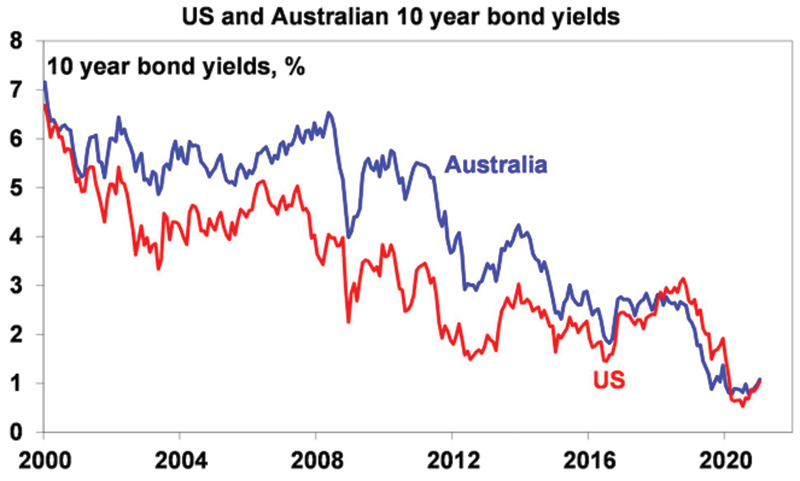
Source: NBER, Bloomberg, AMP Capital
Chart 6 – the gap between earnings and bond yields
The rebound in shares since March has pushed traditional valuations like price to earnings multiples to extremes leading some to fret about overvaluation and a bubble. But shares should trade on higher PEs and hence lower earnings yields when interest rates and bond yields fall. Once this is allowed for, share valuations are not extreme.

Source: Thomson Reuters, AMP Capitall
One way to look at this is to compare the earnings yield on shares (i.e. the inverse of the PE) to the 10-year bond yield. Despite the rally in shares and recent rise in bond yields, it indicates that shares still provide a decent risk premium over bonds. This gap is worth watching – rising bond yields would make shares less attractive, but this can be offset by rising company profits where we expect to see strong gains this year.
Chart 7 – the US dollar
The US dollar is a counter cyclical currency so cyclical moves in it against a range of currencies are of global significance and bear close watching. Because of the relatively low exposure of the US economy to cyclical sectors like manufacturing and materials, the $US tends to be a “risk-of” currency, i.e. it goes up when there are worries about global growth and down when the outlook brightens. And a lot of global debt is denominated in US dollars particularly in emerging countries, so when the $US goes up it makes it tough for emerging countries.
If we are right though and the global economy continues to recover, then the $US is likely to decline further (i.e. the red line in the next chart will fall further) which would be positive for emerging countries. It would also mean more upside for the $A against the $US (i.e. the blue line will continue to trend up) – the big movements in which are primarily a $US story.
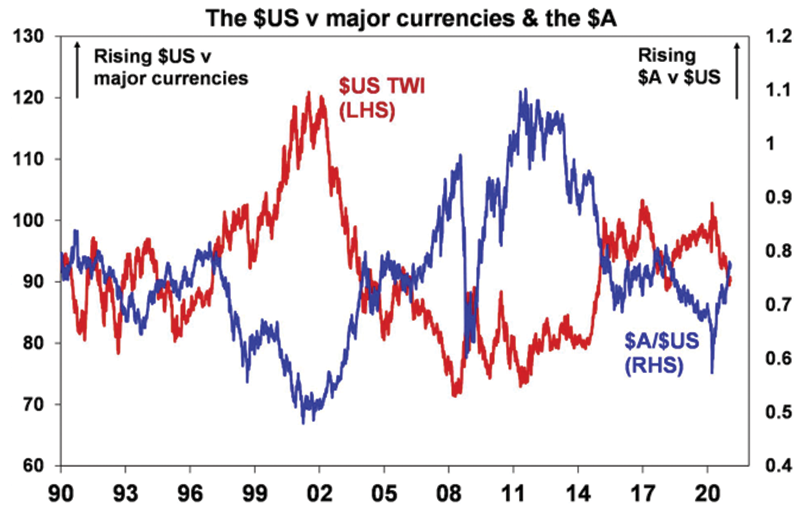
Source: Bloomberg, AMP Capital
Concluding Comments
Well, we survived 2020, what a wide year ending in a huge recovery, as dramatic as the correction which caused it. Thanks again to all our well-advised clients, who heeded our advice to ride the correction out.
Our January 2021 SFP Insight, gives you a snap shot of where we think the world and the world markets are and what to watch out for 2021, as market indicators.
The US elections over now, so we are all getting back to work and hopefully getting ‘the jab’ soon.
The sooner it happens, the sooner the economy will recover. In 2021 we expect to see a lot of volatility. Governments and households have gorged on cheap debt, which inflates shares and property markets. Every concerning news will also scare the markets as nations and households hold more debt. As that continues, a lot of incidental investors will sell hard assets fast causing compounding effect of the market volatility.
After saying that, as interest rates will remain low for a while, governments worldwide wanting to stimulate economies, what better place to invest other than shares and property. So, in short, we see a continued rush to buy these assets as interest rates remain so low and inflation starting to come back.
You can only take advantage of investment opportunities and purchase discounted assets if you have surplus cashflow and cash reserves. Reinvestment plans benefit from dollar cost averaging in volatile markets. Planning for opportunities and guiding our clients in the changing landscape is what we specialise in. This is a cycle that has been going on for hundreds of years, our job is to help our clients navigate this maze and build wealth.
Hang onto your hats as we enter the new year, already full of unexpected ups and downs. No matter what happens in the markets, by the end of 2021 well advised clients will have built considerably more wealth.
Best wishes for 2021, we look forward to advising you in exciting times.
Bill and the team at SFP.
What are the best investment strategies for your 2021 portfolio?
Arrange a meeting to speak with one of our Financial Planners, either book a meeting or call us to arrange an appointment on 02 4229 8533.
This article was prepared by William Bracey and Dr Shane Oliver. Dr Shane Oliver who provides economic forecasts and analysis of key variables and issues affecting, or likely to affect, all asset markets. He also provides economic forecasts and analysis of key variables and issues affecting, or likely to affect, all asset markets.
Important note: While every care has been taken in the preparation of this document, AMP Capital Investors Limited (ABN 59 001 777 591, AFSL 232497) and AMP Capital Funds Management Limited (ABN 15 159 557 721, AFSL 426455) make no representations or warranties as to the accuracy or completeness of any statement in it including, without limitation, any forecasts. Past performance is not a reliable indicator of future performance. This document has been prepared for the purpose of providing general information, without taking account of any particular investor’s objectives, financial situation or needs. An investor should, before making any investment decisions, consider the appropriateness of the information in this document, and seek professional advice, having regard to the investor’s objectives, financial situation and needs. This document is solely for the use of the party to whom it is provided.
General Disclaimer: This article contains information that is general in nature. It does not take into account the objectives, financial situation or needs of any particular person. You need to consider your financial situation and needs before making any decisions based on this information. Please seek personal financial advice prior to acting on this information.

